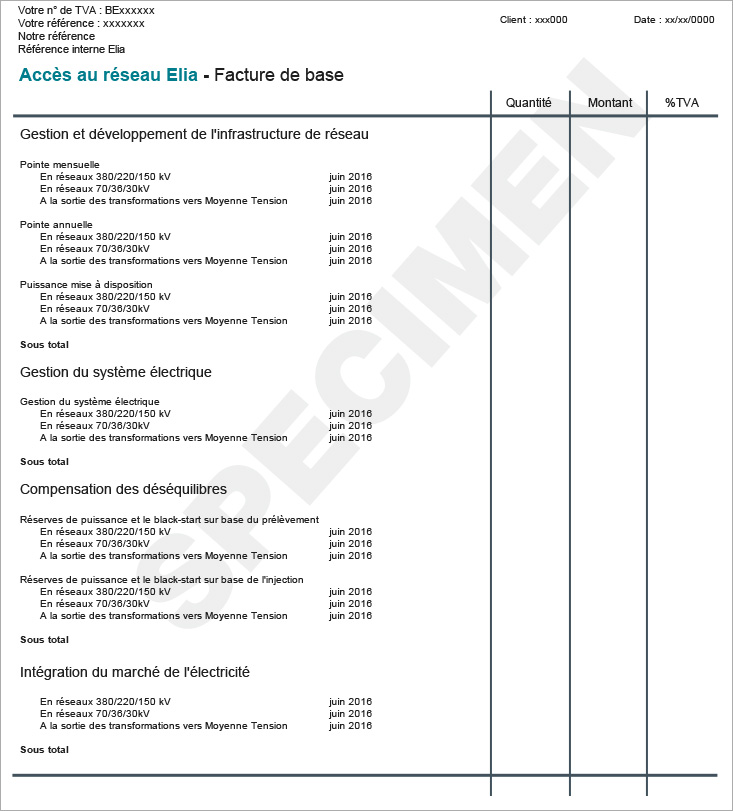Access invoice: the basic invoice
For each month, access holders receive a basic invoice followed by a second invoice. How are these invoices organised and what do they cover?
What are the invoices for?
Grid access invoices cover the tariffs for the operation of the electricity system, the operation and development of the grid infrastructure, the offsetting of imbalances (particularly through the power reserves and black start) and market integration.
Customer hub
Access holders can view their invoices with the Customer Hub application. The section on invoicing includes the invoice itself (in PDF format) plus its appendices, allowing BRP to check their invoices.
Sample invoice

Invoice legend
-
Your reference number
This is the customer’s order number.
-
Elia’s internal reference numberThis is the internal reference number used by Elia. It is different from the contract reference number.
-
Grid infrastructure operation and development
This category consists of three tariffs: the tariff for the monthly peak, the tariff for the yearly peak and the tariff for the power made available. The prepayment for services for month M is equivalent to 90% of the amount invoiced for services in month M−2 for the relevant access points. The second invoice covers the balance. The appendix to the invoice provides details, for each access point covered by the access contract, of how the amounts of the three tariffs for these services are calculated.
Grid infrastructure operation and development services are invoiced on the basis of the power for each of the access holder's access points, as this determines the dimensioning of the grid Elia will have to provide. Power is fixed in terms of net offtake and net injection. The injected power is the difference between the power injected by the generation unit(s) associated with an access point and the power taken off by the load(s) at that access point. If the difference is a negative number, the injected power will be zero. The offtake power is the difference between the power taken off by the load(s) associated with an access point and the power injected by the local generation unit(s) at that access point. If the difference is a negative number, then the offtake power will be zero.
For more about grid access tariffs, see the product sheet titled Objective, transparent and regulated grid access tariffs; and the current tariffs. -
Monthly peak
The amount invoiced is a prepayment for services for month M and is equivalent to 90% of the amount invoiced for month M−2 for the relevant access points. The appendix to the basic invoice provides details, for each access point covered by the access contract, of how the amount of this tariff is calculated.
The monthly peak for offtake is determined, each month, as the maximum peak of power taken off across all the quarter-hours of the month in question. For grid users directly connected to the Elia grid, the tariff for the monthly peak for offtake applies to the 11th peak measured in the month. Elia makes quarter-hourly values available to access holders, enabling them to check their invoices and adjust their consumption profiles accordingly.
For more about the tariff for the monthly peak, see the product sheet titled ‘Objective, transparent and regulated grid access tariffs; and the current tariffs.
More about quarter-hourly data. -
Yearly peak
The amount invoiced is a prepayment for services for month M and is equivalent to 90% of the amount invoiced for month M−2 for the relevant access points. The appendix to the basic invoice provides details, for each access point covered by the access contract, of how the amount for this tariff is calculated.
The yearly peak for offtake is determined ex-post as the maximum peak occurring across all the quarter-hours making up the yearly peak tariff period in the past 12 months, i.e. the current invoicing month and the previous 11 months. The yearly peak tariff period is the period when the total load on the grid is statistically at its highest. Elia makes quarter-hourly values available to access holders, enabling them to check their invoices and adjust their consumption profiles accordingly.
For more about the tariff for the yearly peak, see the product sheet titled ‘Objective, transparent and regulated grid access tariffs; and the current tariffs.
More about quarter-hourly data. -
Infrastructure level
The right to exchange power and energy with the Elia grid is conferred, via the access contract, at access-point level. The Elia grid access tariffs are based on three Contractual Infrastructure Levels (CILs), depending on the voltage at the relevant access point:
- CIL 1: access to the 380 kV, 220 kV or 150 kV grid;
- CIL 2: access to the 70 kV, 36 kV or 30 kV grid;
- CIL 3: access to medium-voltage (less than 30 kV) at the transformer output.
When a grid user has several access points to the Elia grid for the same electrical facilities, one of these may be referred to as the main access point, whereas the others may be called additional access points. The main access point is the one with the most ‘power made available’ (in terms of offtake). The invoice is calculated for each point on the basis of its classification ('main' or 'additional').
For more about the concept of infrastructure level, see the product sheet titled ‘Objective, transparent and regulated grid access tariffs’. -
Power made available
The amount invoiced is a prepayment for services for month M and is equivalent to 100% of the amount invoiced for the power made available at the relevant access points in month M−2.
Grid users have the right to take off and/or inject apparent power from and/or into the grid upstream, in proportion to the apparent power that is made available to them (or in other words, ‘reserved’ for them). The apparent power made available is set out in Appendix 1 to each grid user’s connection contract.
A specific tariff is applied to power made available at the additional access points, corresponding to 20% of the tariff for power made available at a main access point.
For more about the concept of power made available, see the product sheet titled ‘Connecting to the Elia grid: a multi-stage process’.
For more about the tariff for power made available, see the product sheet titled ‘Objective, transparent and regulated grid access tariffs; and the current tariffs. -
Operation of the electricity system
This category consists of two tariffs: the tariff for the operation of the electricity system and the tariff for the offtake of additional reactive energy.
More about quarter-hourly data.
The amount invoiced is a prepayment for services relating to the operation of the electricity system for month M. It is equivalent to 90% of the amount invoiced for month M−2, based on the volume of electricity taken off or injected (in MWh) at the relevant access points. The cost of these services depends on the volume of energy taken off from the Elia grid or injected into it. The appendix to the basic invoice provides details, for each access point covered by the access contract, of how the amounts invoiced for these services are calculated.
The prepayment covers the offsetting of active energy losses on the regional grids. The offsetting of losses on the 380/220/150 kV grids is not invoiced, since the ARPs offset these in kind.
More details about the loss percentage
Elia makes quarter-hourly values available to access holders, enabling them to check their invoices and adjust their consumption profiles accordingly.
For more about the tariff for the operation of the electricity system, see the product sheet titled ‘Objective, transparent and regulated grid access tariffs; and the current tariffs. -
Offsetting imbalances
This category consists of two tariffs, namely the tariff for power reserves and black start and the tariff for maintaining and restoring the residual balance of individual ARPs, for which they are invoiced directly (see invoicing for balancing). This tariff is applied equally to each access point for offtake and injection, regardless of the infrastructure level to which the relevant grid user is connected, because the service is the same for every access point.
The amount invoiced is a prepayment for the offsetting of imbalances for month M. This prepayment is equivalent to 90% of the amount invoiced for the services in respect of month M−2 for the relevant access points.
For more about the tariff for offsetting imbalances, see the product sheet titled ‘Objective, transparent and regulated grid access tariffs; and the current tariffs. -
Market integration
The tariff for market integration relates to a range of services provided by Elia, including the development and integration of an effective and efficient electricity market, the management of interconnections, coordination with neighbouring countries and the European authorities, and the publication of data as required by transparency obligations.
The amount invoiced is a prepayment for market integration services for month M. This prepayment is equivalent to 90% of the amount invoiced for the service in respect of month M−2 for the relevant access points.
For more about the tariff for market integration, see the product sheet titled ‘Objective, transparent and regulated grid access tariffs; and the current tariffs.


